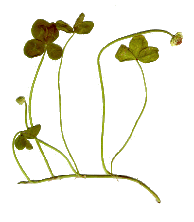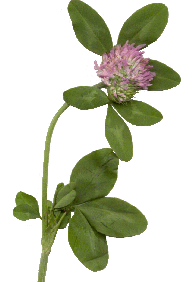Alsike clover poisoning, photosensitization or photodermatitis in horses
Learn about the syndromes in horses caused by alsike clover.
Introduction
Alsike clover (Trifolium hybridum) is found most frequently in the farming areas of northern Canada but has been included in a number of commonly used pasture mixes. This plant is adapted to cool climates and heavy, poorly drained clay soils. It grows 15–30 inches in height with a small ½–inch diameter pink flower, which forms at the ends of secondary branches from the main stem. It should be differentiated from red clover, which has a larger flower, hairy stems and leaves and a white inverted "V" on the leaf similar to the white clovers.
Alsike clover is know to cause two syndromes, photosensitization and big liver syndrome. The original condition was described by Dr. Schofield, former Dean of the Ontario Veterinary College
Alsike

- small ½–inch pink flower
- grows 15–30 inches high
- no white "V" on the leaves
The more common and acute lesions related to alsike clover are photosensitization characterized by "reddening of the skin under the influence of sunlight, followed by either superficial or deep dry necrosis of the skin or by edematous swelling and serous discharge," resulting in crusty inflamed areas, especially in the unpigmented pink-skinned areas of the face. Kingsbury also describes "symptoms of nervous and digestive disorders," including colic and diarrhea and oral lesions related to alsike clover poisoning
Horses that are not outside during the day, blanketed while outside, or have minimum exposure to ultraviolet light may not show the hair loss and crusty inflamed skin typical of photosensitization. In these cases, a slight edema of the skin may be the only noticeable sign. Close observation of the oral mucosa of the mouth and under the tongue may reveal peticheal haemorrhage and linear ulcers. Diarrhea and colic may also be experienced.
The longer-term consequence of alsike clover consumption is "big liver syndrome", appearing as a progressive destruction of the liver with increased connective tissue (biliary cirrhosis). It appears that this is related to the accumulation of a yet unidentified toxin. The primary tests for evaluating liver function and hepatic disease measure the serum enzyme activity of aspartate amino transferase (AST), gamma glutamyl transferase (GGT), sorbitol dehydrogenase (SDH) and lactic dehydrogenase - 5 (LDH-5). Liver biopsy may be required to characterize the degree and type of liver damage and provide a prognosis.
Veterinarians will need to differentiate between alsike clover poisoning and other types of photosensitization by walking horse pastures and examining hay for potential photodynamic agent-containing plants. Photodynamic agents in certain plants accumulate in the liver and react with ultraviolet light to cause the dermatitis. This is commonly seen in pyrrolizidine alkaloid-containing plants, such as tansy ragwort, groundsel, fiddleneck, common heliotrope, vipers bugloss (blue weed), and rattlebox. Phenothiazine-derived anthelmintics, sulfonamides, and tetracyclines have also been associated with this condition. Descriptions and images of many of these plants can be viewed by accessing the Canadian Poisonous Plants Information System.
The following general descriptions of the non toxic white and red clovers will help veterinarians and horse owners distinguish them from alsike clover.
White Dutch or Common White

- low-growing plant (less than 5 inches)
- leaves and flowers rise from a horizontal creeping stem
- leaves have an inverted white "V"
White Dutch or Common White clover (Trifolium repens) is a low-growing plant (less than 5 inches) which grows well in pastures. Ladino clover is a taller improved white clover. It grows to 12–15 inches in height with a 3/4 to 1–inch diameter white flower. The white clovers grow from a creeping stem. Leaves and flowers rise individually from the horizontal stem. The leaves have an inverted white "V".
Red

- 3/4 to 1–inch rose-purple flowers
- grows 12–15 inches in height
- leaves and flowers rise from a vertical stem
- leaves and stems are hairy
- leaves have a white "V"
Red clover (Trifolium pratense) is a biennial, which means it will live for about two years and then will die off unless it is allowed to re-seed itself. The stem is vertical with leaves and flowers rising from the stem. It grows to 12–15 inches in height with 3/4 to 1–inch diameter rose-purple to magenta flowers. The stems and leaves are hairy. The hairs form a fine dust when cured for hay. The leaves are green with a white "V".
Summary and recommendations
Alsike clover poisoning does not appear to occur all the time. It may be that a fungus growing on the plant creates a mycotoxin or the plant creates or accumulates a toxin under certain environmental growing conditions. However, until the toxin and the circumstances affecting the accumulation of the toxin are discovered:
- alsike clover should not be fed to horses in greater than 5% of the feed
- seed mixes intended for horse pastures and hay should not contain alsike clover
- horse owners should be able to recognize the different clovers so that alsike clover poisoning can be prevented
Footnotes
- footnote[1] Back to paragraph Rooney JR, Robertson JL. Equine Pathology. Ames: Iowa State University Press, 1996: p110.
- footnote[2] Back to paragraph Munro DB. Canadian Poisonous Plants Information System. Agriculture and Agri-Food Canada.
- footnote[3] Back to paragraph Kingsbury JM. Poisonous Plants of the Unites States and Canada. Englewood Cliffs, New Jersey: Prentice-Hall Inc., 1964:358-360.